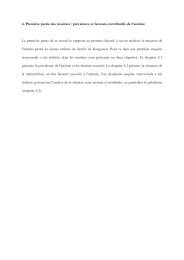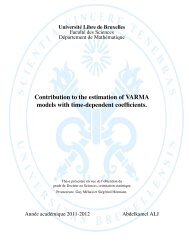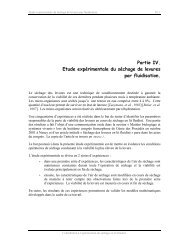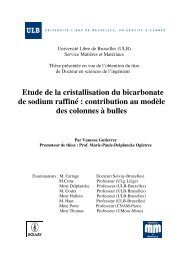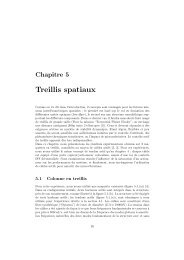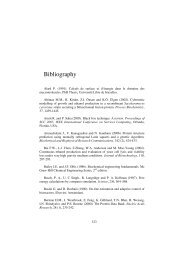Diapositive 1 - de l'Université libre de Bruxelles
Diapositive 1 - de l'Université libre de Bruxelles
Diapositive 1 - de l'Université libre de Bruxelles
Create successful ePaper yourself
Turn your PDF publications into a flip-book with our unique Google optimized e-Paper software.
Chapitre Vcontrol of ion concentrations in the calcifying space were suggested to be involved(Bentov & Erez 2006), but the relative effects of these parameters are still unexplored.At a constant temperature, the Mg/Ca ratio of in vitro <strong>de</strong>posited calcite is affected by thesame ratio in the solution. Skeletal Mg/Ca ratios of calcifying organisms grown inexperimental conditions were also shown to be directly, but not linearly, controlled by theMg/Ca ratio of seawater (Lorens & Ben<strong>de</strong>r 1980, Ries 2004). Biogenic calcites formthrough a transient phase of amorphous calcium carbonate (Aizenberg et al 1996a,Beniash et al 1997, 1999, Politi et al 2004) which has been suggested to affect themagnesium signature of the final crystal (Loste et al 2003, Wang et al 2009). Loste et al(2003) showed that the Mg/Ca ratio of transient amorphous calcium carbonateprecipitated in vitro was related to the Mg/Ca ratio of the precipitation solution, and<strong>de</strong>termined the magnesium concentration in the resulting crystals. Han et al (2005) andCheng et al (2007) showed a nearly linear increase of magnesium content of in vitroprecipitated calcium carbonate minerals with the Mg/Ca ratio of the precipitationsolution.The ability of synthetic organic molecules to affect the magnesium concentration incalcites has been <strong>de</strong>monstrated by in vitro precipitation experiments. Kitano & Kanamori(1966) showed that sodium citrate and malate enhance magnesium incorporation intocalcite and reduce the formation of aragonite, which is the dominant precipitated mineralin inorganic magnesium-rich solutions. Biomimetic pepti<strong>de</strong>s and polypepti<strong>de</strong>s (asparticacids) induce similar promoting effects on magnesium incorporation into calcite (Chenget al 2007, Stephenson et al 2008). However, Falini et al (1994) reported that magnesiumincorporation into crystals grown in vitro in presence of poly-L-aspartate was notenhanced, although this compound promoted the formation of calcite in magnesium-richsolution.Very few studies investigated the effect of genuine organic matrix molecules onmagnesium incorporation. According to these, the presence of organic matrix had no orlow impact on magnesium concentration in the precipitated mineral (Raz et al 2003,Gayathri et al 2007). However, these studies used only a single matrix concentration and,one of them a single solution Mg/Ca ratio, preventing a firm conclusion.95



